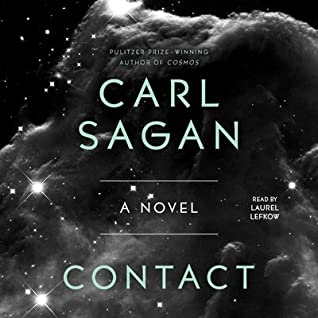- The Good: Quintessential hard and hopeful scifi
- The Bad: May be science-heavy for those unfamiliar—pace yourself
- The Literary: Realistic scifi and its intersections with religion and politics
Eleanor (Ellie) Arroway has a strong aptitude for science and mathematics, encouraged by her father and role model since she was a little girl. After graduating from Harvard and Caltech, she directs a project at a radiotelescope array in New Mexico. Despite funding difficulties and opposition from her old doctoral thesis advisor, Ellie discovers a signal of prime numbers broadcasting from the Vega system, 26 light-years away.
Carl Sagan was an American astronomer and science educator, focused on the search for intelligent life. He sent the first physical messages into space, including the Voyager Golden Record. He promoted the scientific method and skeptical inquiry in the television series Cosmos, the most widely watched series in the history of public television, which inspired many young scientists. He published over 600 scientific papers and contributed to over 20 non-fiction books. Contact is his only novel.
With the author in mind, it may not surprise you that Contact is a hard science fiction story that delights in the technical details of radio telescopes, decryption, and transcendental numbers. Ellie’s awe and wonder at the universe help communicate some of the more theoretical concepts. Even if you aren’t well versed in science, it’s clear that Ellie is searching for truth. She’s passionate but she’s also a skeptic, and when the first message is received, her team explores all possible avenues for a forgery or coincidence in a logical stepwise fashion, and it’s nice to see the scientific “Eureka!” moment in action as “Wow, that’s interesting”, followed by a systematic process of proof.
Soon after discovery of the message, the rotation of the Earth means that Ellie’s team will lose visibility of the Vega system until the next day, so Ellie contacts their astronomer counterparts on the other side of the world to continue the investigation. I love the presence of the scientific community in this book, who work cooperatively from the start, understanding that the extraterrestrial message does not care about Earth’s internal borders. Throughout the book, Ellie sets up a redundant monitoring system with the help of her Soviet colleague Vaygay Lunacharsky, receives crucial advice from the tech billionaire S. R. Hadden, develops a friendship with the stately Indian physician and molecular biologist Devi Sukhavati, and couples-up with US’s Presidential Science Advisor Ken der Heer. Though she first discovers the message, scientists and enthusiasts from all over the world contribute to decoding it. Like I said, it’s a broad and highly cooperative international scientific community. This is particularly poignant considering this book was written deep into the Cold War era.
Unfortunately for Ellie, she lives in a world with both politics and religion. She must work within the boundaries set by the US President and her advisors, who desire to maintain an advantage over the other countries in the world (which means less collaboration with other scientists) as well as exercise extreme caution in communication with aliens who are mostly likely a much more powerful species.
For the sake of publicity, Ellie agrees to meet and publicly debate two religious advisors, Billy Jo Rankin and Palmer Joss. Ellie is a skeptic, and says there isn’t any proof that god exists, and until there is proof, she won’t believe in a higher power. Both Rankin and Ellie both lose their temper a few times, but Ellie finds she can have long philosophical discussions with Joss about the meaning of life and our purpose in the universe. Their friendship represents a hopeful theme of open-minded, tolerant, and literate collaboration between religion and science.
I also love that Sagan doesn’t shy away from the darkest moments we are capable of as a species. After some modulation of the polarity of the message from Vega, Ellie’s team discovers a re-transmission of the first television signal ever strong enough to escape Earth—the opening speech of the 1936 Summer Olympics in Berlin by Adolf Hitler. Even as we reach for the stars, we are reminded of how far we’ve come in such a short time and of how close we’ve come to destroying ourselves, be it by genocide or the Cold War.
Mostly I’ve talked about the big implications of this story, politics, religion, philosophy, and the history of the human species. But Contact is also a tragic personal character journey for Ellie. She never gets over the loss her father and mentor at such a young age. She never accepts her stepfather as a part of her family and thinks her mother weak for re-marrying. As an adult she’s too busy to call or visit her mother, until tragedy strikes again.
At the end of the story, after Ellie discovers the truth of the universe, she also discovers a new truth about her family. She’s more prepared for the grand humanity-changing truth than the revelation that affects just a few people, but Ellie slowly comes to terms with it, always searching, always looking for proof, determined to uncover the secrets of the universe, even if they change everything we know about ourselves.
Highly recommended for everyone! Hail Sagan!
